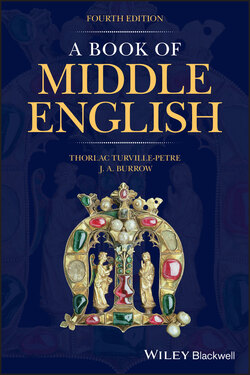Читать книгу A Book of Middle English - J. A. Burrow - Страница 28
4.2 Nouns 4.2.1 Introduction
ОглавлениеThe blurring of vowels in unstressed syllables had consequences that may clearly be seen in the noun inflexions. The system in Old English was complex, with differentiation possible between gender, case, and strong and weak classes. So the nominative plural of nouns might be marked by ‐as, ‐u, ‐a, ‐e, ‐an or no ending at all, and other endings distinguished one case from another. With the falling together of unstressed vowels, the whole variety of inflexional endings was reduced to ‐e, ‐es, ‐en and ‐ene. In practice only those forms ending in a consonant, ‐es and ‐en, were sharply distinctive, and therefore they were useful as grammatical markers, to indicate possession and to distinguish the plural. The ending ‐es was the marker of the genitive singular of the Old English strong masculine nouns; it was the most distinctive of all the endings in the singular, and in Middle English it became generalized to serve as the ending for the genitive of the great majority of nouns, and indeed the only singular inflexion that regularly survived. Similarly the ending ‐as, the nominative and accusative plural ending of Old English strong masculine nouns, developed into ‐es in Middle English, and in many dialects became the usual way of marking the plural. Southern dialects, on the other hand, preferred the ‐en ending of the plural, derived from the Old English weak plural ending ‐an, and extended this ending to nouns that historically had other endings, as in shon, ‘shoes’ (OE plural scōs), and sunnen, ‘sins’ (OE plural synna). These endings, either ‐es or ‐en, were then extended throughout the plural, until there was no distinction of case there.
In this way the modern system of noun inflexions was reached, with distinctions in form only between singular and plural, and between the genitive singular and the other cases of the singular. (The use of an apostrophe to mark the genitive singular and genitive plural is a written convention regularized in the eighteenth century.) The concept of grammatical ‘case’ had thus been all but eliminated in the nouns, and grammatical function in Middle English is instead indicated by relatively fixed word‐order and the greatly increased use and variety of prepositions. A further consequence of the reduction of distinctive noun inflexions is that there is no longer any indication of grammatical gender except sometimes in the accompanying articles and pronouns. In Early Middle English grammatical gender survives to a limited extent (see 5.1 below); soon, however, natural gender takes its place; that is, the gender of pronouns and the like is determined not by the grammatical gender‐class of the nouns to which they refer, but by the natural distinction between human male, human female, and non‐human.
